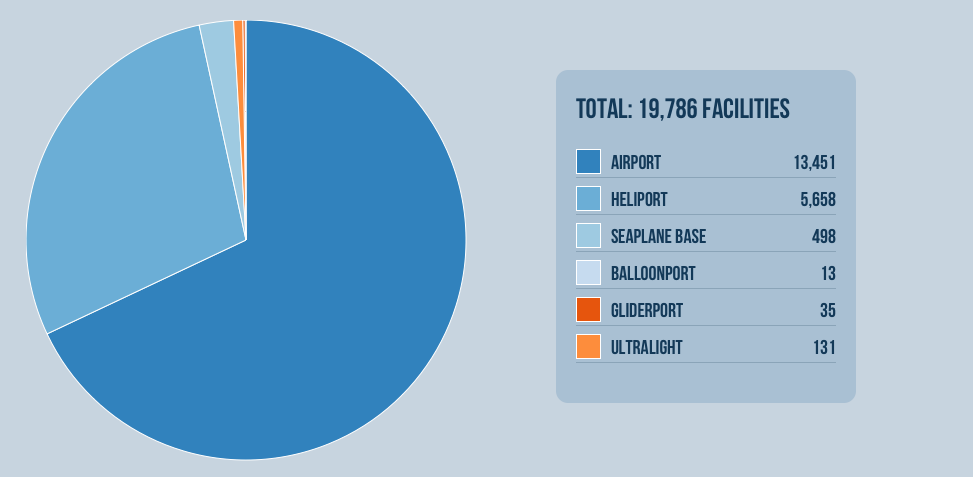AMERICAN SOCIETY OF CIVIL ENGINEERS
Despite the effects of the recent recession, commercial enplanements were about 33 million higher in number in 2011 than in 2000, stretching the system’s ability to meet the needs of the nation’s economy. The Federal Aviation Administration (FAA) estimates that the national cost of airport congestion and delays was almost $22 billion in 2012. If current federal funding levels are maintained, the FAA anticipates that the cost of congestion and delays to the economy will rise from $34 billion in 2020 to $63 billion by 2040.
Aviation: Conditions & Capacity
The U.S. aviation industry is made up primarily of airports, the air traffic control system, and aircraft (commercial and private). The United States has 3,330 existing public use airports and 25 proposed airports, which make up the National Plan of Integrated Airport Systems (NPIAS). NPIAS airports are those which the FAA considers significant to national air transportation and are eligible to receive Airport Improvement Program (AIP) grants. Of these airports, 499 accommodate scheduled air carrier service including:
- 29 large hub airports;
- 36 medium hub airports;
- 74 small hub airports;
- 239 nonhub primary airports; and
- 121 nonprimary commercial service airports.
The NPIAS system also includes 2,563 general aviation airports and 268 reliever airports. Airports not included in the NPIAS system include facilities closed to the public or those that do not meet the NPIAS criteria. The total U.S. aviation system includes approximately 617,128 pilots, 222,520 general aviation aircraft, 7,185 air carriers, and a total 19,734 landing areas. Among airports the 29 major hubs play a dominant role in the economy, and the top 15 metropolitan areas with their 35 airports account for 80% of U.S. passenger origins and destination movements, totaling 343 million trips. Similar to passenger travel, freight air shipments are also concentrated in major metro areas, with 70% of domestic air tonnage originating in key metro markets.
The U.S. airport system accommodates more than $562 billion in cargo annually in addition to 728 million passenger enplanements. By 2040, the U.S. airport system will carry more than one billion passengers and that air freight tonnage could grow by nearly 200%. A growth in demand could have major ramifications for the U.S. economy. In 2011, the FAA reported that the total output of aviation-related goods and services amounted to $1.3 trillion in 2009, and generated more than 10 million jobs.
Since 2003, the FAA has been planning and developing the Next Generation Air Transportation System (NextGen), which would replace the nation’s 1960s radar technology with a satellite-based air traffic control system. The NextGen system is intended to improve the efficiency and safety of air traffic flow into and out of airports. By improving the flow of air traffic, NextGen is expected to increase capacity of the air transportation system so that future growth can be accommodated while maintaining safety. FAA’s capital investment in NextGen is anticipated to be over $11 billion by 2018, and full implementation of NextGen is projected to cost at least $32 billion by 2025. However, this does not include the research, airport and associated airfield improvements, or the aircraft equipment needed to realize all the benefits of NextGen.
Despite tough economic times, the aviation industry has proved to be fairly stable for passenger travel. Passenger enplanements for U.S. airlines at home and abroad increased slightly by 3.5% in 2011. This continues the post-September 11, 2001 trend, from a low of 612 million passengers in 2002, to 728 million passengers in 2011. In addition to the airline passenger industry, air cargo is important to the U.S. economy, as 30% of exports and 20% of imports measured by value in 2008 were shipped by air. The FAA forecasts an annual average rate of growth of 5.1% through 2030.
The FAA continues to have as its performance goal that 93% of runways in NPIAS airports are maintained in excellent, good, or fair condition. Data for 2011 indicate that 97.5% of runways at NPIAS airports meet that goal, with pavement at commercial airports being better, with 98% meeting the goal. Capacity of runways is also limited by their length as shorter runways cannot accommodate larger airplanes.
In 2011, U.S. air carriers reporting performance reported an overall on time rate of 79.6%. For 2011, 18% of flights were delayed and almost 2% of flights were cancelled.
General aviation is an important part of the aviation community, with more than 222,520 aircraft, including business jets, leisure, law enforcement, medical transportation, agricultural services, and others. The FAA notes that between 2000 and 2009, general aviation flight hours dropped nearly 25%, with fuel costs and aviation security changes as the primary reasons. General aviation’s total economic impact was estimated to be $76.5 billion in 2009, down sharply from the $97.2 billion in 2008.
The cost of airport congestion and delays to the national economy was $21.9 billion (adjusted to 2010 dollars) in 2007. If current funding levels are maintained, the FAA further estimates that the cost will rise from $24 billion in 2012 to $34 billion in 2020 and can be expected to reach $63 billion by 2040.
View Full Report (ASCE.org): Aviation Grade: 2013 Report Card for America’s Infrastructure
About the American Society of Civil Engineers (ASCE)
www.asce.org
““Founded in 1852, the American Society of Civil Engineers (ASCE) represents more than 147,000 members of the civil engineering profession worldwide, and is America’s oldest national engineering society. ASCE’s vision is to position engineers as global leaders building a better quality of life…Comprised of Regional Councils, Younger Member Councils, Sections, Branches, Student Chapters and Clubs and International Student Groups, the Society and its volunteers are fully engaged in making this a better world by design.”
Tags: American Society of Civil Engineers, ASCE, ASCE Report Card, Report Card for America's Infrastructure








 RSS Feed
RSS Feed